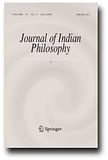Journal of Indian Philosophy 2011 - 39,1
Verfasst von pw am Mo, 07/25/2011 - 22:22.
Journal of Indian Philosophy
Journal of Indian philosophy / Editor-in-Chief: Phyllis Granoff. - Vol. 39,1. - Dordrecht [u.a.] : Springer [u.a.], 2011.
ISSN 0022-1791 (Printausg.)
ISSN 1573-0395 (Online-Ausg.)
URL: Homepage
URL: Online-Ausg. (Springerlink)
Inhalt: 39,1 (2011)
Sondernummer: Special on Rethinking the History of the Kama World in Early India / guest editor: Daud Ali
Daud Ali: Rethinking the History of the Kāma World in Early India. - In: JIP. - 39,1 (2011), S. 1-13
DOI: 10.1007/s10781-010-9115-7
DOI: 10.1007/s10781-010-9115-7
This essay introduces a special issue on the history of kāmaśāstra in medieval India. It briefly reviews the secondary scholarship on the subject from the publication of the first translations of the genre at the end of the nineteenth century. It highlights the relatively unexplored history of later kāmaśāstra, and stresses the need for contexualized and detailed studies of the many kāmaśāstra treatises produced in the second millennium CE. The introduction, and the essays that follow, also argue for an expanded interpretive framework for the genre, moving beyond ‘sex’ and ‘sexuality,’ to a more widely defined notion of a ‘kāma world’, in which sensual pleasure is understood as being deeply enmeshed with aesthetic, ethical and cosmopolitan cultures.
Laura Desmond: The Pleasure is Mine: The Changing Subject of Erotic Science. - In: JIP. - 39,1 (2011), S. 15-39
DOI: 10.1007/s10781-010-9117-5
DOI: 10.1007/s10781-010-9117-5
Abstract: Pleasure, the defining object of kāmaśāstric scholarship, is harmonious sensory experience, the product of a “good fit” between the self and the world. It comes about when one moves in a world of fitting sense objects, and one has made oneself fit to enter that world. The bulk of kāmaśāstric literature is devoted to developing, enhancing, and enacting specific bodily and sensory capabilities in order to maximize one’s ability to affect and be affected by the world. This article examines the model of subjectivity implied by kāmaśāstra, tracking two sorts of changes to the self assumed by this body of texts. First, it presents and analyzes the ways in which the social actors described in this literature come into being in and through the cultivation and performance of particular bodily and social acts; the “artifactual” nature of the self is presumed. Second, it considers the changing set of acts that are described and prescribed over the course of kāmaśāstric history, noting the increasing place of physiognomy and of magico-medical alterations of the body, and the elision of the social sphere of sensual activity. Finally, this article situates the kāmaśāstric model of subjectivity in relation to the larger śāstric project, drawing out the model of empiricism that it presupposes, and speculating upon the epistemological/ontological implications of kāmaśāstra as a science.
Daud Ali: Padmaśrī’s Nāgarasarvasva and the World of Medieval Kāmaśāstra. - In: JIP. - 39,1 (2011), S. 41-62
DOI: 10.1007/s10781-010-9116-6
DOI: 10.1007/s10781-010-9116-6
Abstract: This essay focuses on a neglected and important text, the Nāgarasarvasva of Padmaśrī, as an index to the changing contours of kāmaśāstra in the early second millennium (1000-1500) CE. Focusing on a number of themes which linked Padmaśrī’s work with contemporary treatises, the essay argues that kāmaśāstra incorporated several new conceptions of the body and related para-technologies as well as elements of material and aesthetic culture which had become prominent in the cosmopolitan, courtly milieu. Rather than seeing this development as an attenuation of the earlier science as constituted by Vātsyāyana’s Kāmasūtra, it is possible to see that kāmaśāstra actually developed closer relations with fields of knowledge that had long developed alongside it.
James McHugh: The Incense Trees of the Land of Emeralds: The Exotic Material Culture of Kāmaśāstra. - In: JIP. - 39,1 (2011), S. 63-100
DOI: 10.1007/s10781-010-9118-4
DOI: 10.1007/s10781-010-9118-4
Abstract: One of the many topics discussed in texts of kāmaśāstra is the ideal material environment for the pursuit of sensory pleasures. Later medieval texts describing the pursuit of pleasure and the typical lifestyle of the cultivated urban man focus in increasing detail on the informed consumption of certain luxury commodities, such as perfumes and gemstones. This pleasure-expertise was increasingly valued, such that by the twelfth century one encyclopedia of royal life, the Mānasollāsa, was effectively a vast textual monument to the masterful king’s capacity to enjoy the world. Not only were luxury raw materials subject to a discourse of connoisseurship, but in many cases the exotic nature of these materials was equally celebrated. This preoccupation with the exotic nature of luxury materials displays wide-ranging power at the center of consumption, whilst betraying a truly cosmopolitan fascination with remote, possibly unconquered lands of plenty, whose foreign and beautiful products were essential to the pursuit of erudite pleasures in temple and court alike.
Deven M. Patel: Shared Typologies of Kāmaśāstra, Alaṅkāraśāstra and Literary Criticism. - In: JIP. - 39,1 (2011), S. 101-122
DOI: 10.1007/s10781-010-9119-3
DOI: 10.1007/s10781-010-9119-3
Abstract: This paper brings kāmaśāstra into conversation with poetics (alaṅkāraśāstra) and modes of literary criticism associated with Sanskrit literature (kāvya). It shows how historical intersections between kāvya, kāmaśāstra, and alaṅkāraśāstra have produced insightful cross-domain typologies to understand the nature and value of canonical works of Sanskrit literature. In addition to exploring kāmaśāstra typologies broadly as conceptual models and analytical categories useful in literary-critical contexts, this paper takes up a specific formulation from the kāmaśāstra (the padminī-citriṇī-śaṅkhinī-hastinī type-casting of females) used by a twentieth century literary critic to frame the relationships between canonical poets of Sanskrit literature.
Ähnlich
- Sambhasa 2013 - 30
- Journal of Indian Philosophy 2011 - 39,6
- Sambhasa 2011 - 29
- Studies in Indian philosophy and Buddhism 2011 - 18
- Journal of Indian Philosophy 2011 - 39,4-5
- Journal of Indian Philosophy 2011 - 39,3
- Journal of Indian Philosophy 2011 - 39,2
- Asian Philosophy 2011 - Vol. 21,1
- Journal of Indian Philosophy 2010 - 38,2-4
- Journal of Indian Philosophy 2010 - 38,1

